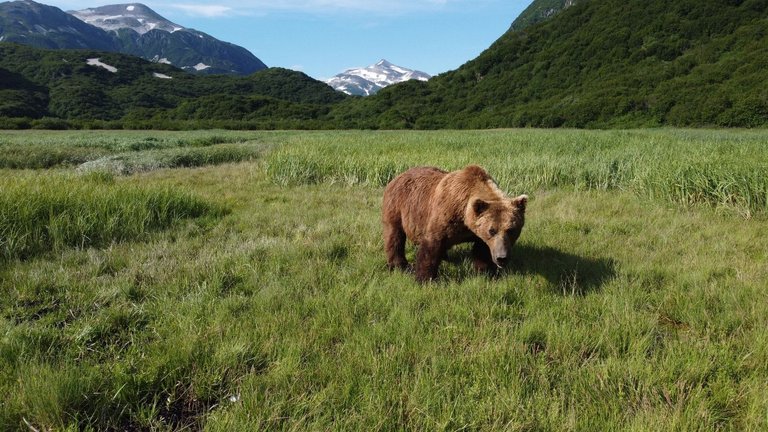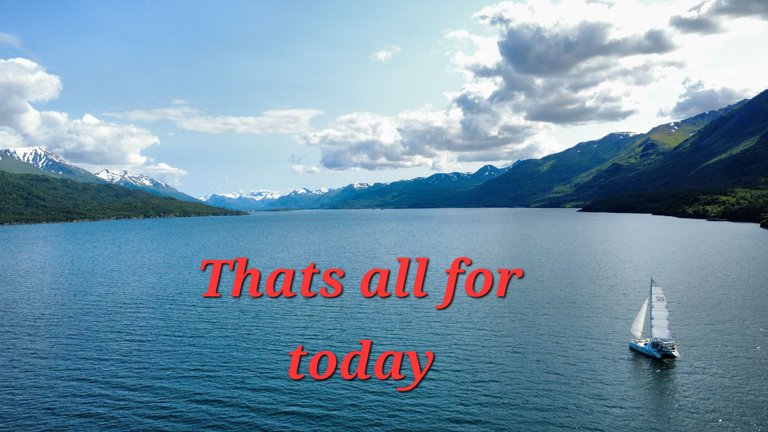Our Kodiak Circumnavigation! 11 Weeks long. [ENG-GER]
![20250727_170521[1].jpg](https://images.hive.blog/768x0/https://files.peakd.com/file/peakd-hive/konquest/23uFPUgcekUE5AYbnyMmSsz9vu3hbdQLTvFzJonuM2d9CVqPhpZWEv59773Ti2fVJqr7M.jpg)
As you can see in the image above, we’ve finally finished circumnavigating Kodiak, and it took us about 11 weeks. Before we begin, I want to clarify that the bear image is NOT a Kodiak bear—it was taken last year. Unfortunately, we haven’t been able to photograph any bears on this trip, which is why we’re using this older photo.
This post will be a bit different from the others, as I’ll only be sharing photos that highlight our journey around Kodiak, along with some interesting facts we learned about the island.
DEUSTCH:
Wie ihr auf dem Bild oben sehen könnt, haben wir es endlich geschafft, Kodiak zu umrunden – und das hat uns etwa 11 Wochen gekostet. Bevor wir anfangen, möchte ich klarstellen, dass das Bärenfoto KEIN Kodiak-Bär ist. Das Foto wurde letztes Jahr aufgenommen. Leider ist es uns auf dieser Reise nicht gelungen, einen Bären zu fotografieren, deshalb verwenden wir dieses ältere Bild.
Dieser Beitrag wird etwas anders sein als die vorherigen, denn ich werde nur Fotos zeigen, die die Highlights unserer Umrundung Kodiaks festhalten, zusammen mit einigen interessanten Fakten, die wir über die Insel gelernt haben.
![dji_fly_20250630_132356_32_1751318646345_photo_optimized[1].jpg](https://images.hive.blog/768x0/https://files.peakd.com/file/peakd-hive/konquest/23rB1ShUZGxfvm7UUnjQDM1BX3mkzXCPevtQDTnC4zPciCaxSaEF4YLE3Sg7oi5U6RYZm.jpg)
![dji_fly_20250630_132928_50_1751319064630_photo_optimized[1].jpg](https://images.hive.blog/768x0/https://files.peakd.com/file/peakd-hive/konquest/244eEAT5niFDQJURLtaPT6gawZQBGf9eeSRAj5WCh95aDD1F2RqGN7XtFqP6QZNT8aD85.jpg)
This is Akihiok, if you're interested l have already posted about this village be sure to check it out 'here'. DUETSCH: Das ist Akihiok. Falls ihr euch dafür interessiert, ich habe bereits einen Beitrag über dieses Dorf veröffentlicht – schaut gerne [hier] vorbei!
About Kodiak Island;
This village is located quite far south, and as you can see, there are barely any trees. Why? Beyond a certain latitude or elevation, cold temperatures, strong winds, and short growing seasons prevent trees from surviving. This is what makes Kodiak unique—just about 30 nautical miles (55 km) north, the island is lush with trees!
DEUTSCH:
Dieses Dorf liegt ziemlich weit im Süden, und wie man sieht, gibt es hier kaum Bäume. Warum? Ab einem bestimmten Breitengrad oder einer bestimmten Höhe verhindern kalte Temperaturen, starke Winde und kurze Vegetationsperioden, dass Bäume überleben können. Das macht Kodiak so einzigartig: Nur etwa 30 Seemeilen (55 km) nördlich ist die Insel dicht bewaldet!
![dji_fly_20250711_094316_130_1752255805028_photo_optimized[1].jpg](https://images.hive.blog/768x0/https://files.peakd.com/file/peakd-hive/konquest/242NcpHzqKf4Cj8A71ZUoQ1FHseMoE3wMHHZ3WnBEx6vfQn1eFA4RC8CU4sjVMa2Y5zJP.jpg)
![dji_fly_20250711_094610_135_1752255978965_photo_optimized[1].jpg](https://images.hive.blog/768x0/https://files.peakd.com/file/peakd-hive/konquest/241tSxUmLJN7DPAeZ4D1wXfs8waKcRGXi1DNEPiN1dJMaSj5Z53qo2Yw1AuAxQebPjF38.jpg)
This is part of Uqak or as l called it Chicken Foot Cove, l also posted about this on my blog - be sure to check that out 'here'. DUETSCH: Dies ist ein Teil von Uqak, oder wie ich es nenne, "Chicken Foot Cove". Ich habe darüber auch in meinem Blog geschrieben – schaut gerne mal [hier] vorbei!
But as you can see, there are significantly more trees here. Research shows that on Kodiak Island, the tree line is advancing southward at a rate of 1.5 miles (3 km) per year.
DUETSCH:
Aber wie Sie sehen können, gibt es hier deutlich mehr Bäume. Forschungen zeigen, dass sich die Baumgrenze auf Kodiak Island jährlich um 1,5 Meilen (3 km) nach Süden verschiebt.
About the Kodiak Bear:

As I mentioned earlier, this is NOT a Kodiak bear - it's a brown bear. Since we didn't encounter any Kodiak bears during our trip, I had to use this photo of a brown bear instead. DUETSCH: Wie ich bereits erwähnt habe, ist dies KEIN Kodiakbär, sondern ein Braunbär. Da wir auf unserer Reise keine Kodiakbären gesehen haben, musste ich stattdessen dieses Foto eines Braunbären verwenden.
Found only on Kodiak Island, these massive brown bears are the largest on Earth, with males weighing up to 1,800 lbs—thanks to a rich diet of salmon, berries, and clams. Unlike inland grizzlies, Kodiak bears tolerate each other at crowded salmon streams but turn solitary otherwise. When winter comes, they den up from October to April, with pregnant females giving birth mid-hibernation to tiny, blind cubs—while fast asleep! Females nurse their cubs in the den for months before emerging in spring, teaching them survival skills for three years before kicking them out. With only about 3500 bears we weren't lucky enough to see a single one!
DUETSCH: Diese riesigen Braunbären kommen ausschließlich auf der Kodiak-Insel vor und sind die größten Landraubtiere der Erde. Ausgewachsene Männchen können bis zu 816 kg wiegen – begünstigt durch ihre proteinreiche Ernährung aus Lachsen, Beeren und Schalentieren. Anders als ihre Verwandten, die Inland-Grizzlies, zeigen Kodiakbären einzigartige soziale Toleranz: Sie versammeln sich friedlich an Lachsflüssen, bevor sie wieder zu Einzelgängern werden. Ihr bemerkenswerter Lebenszyklus umfasst:
Winterschlaf (Oktober-April), während dem trächtige Weibchen schlafend gebären
Winzige Jungtiere (nur 0,5 kg schwer) säugen monatelang in der Höhle
3-jährige Lehrzeit, in der Mütter Überlebensfähigkeiten vermitteln
Bei nur etwa 3.500 Tieren auf dem Archipel hatten wir kein Glück, einen zu sehen!
![Screenshot_20250730_094604_Gallery[1].jpg](https://images.hive.blog/768x0/https://files.peakd.com/file/peakd-hive/konquest/23uQn93XWxxMG9TTDAmCPb8KhTgiefm84vjZzXxTm9nMQtBp3ea22pWKrA5RCctJeQLpS.jpg)
Kodiak has left an indelible mark on our hearts. These past 11 weeks have been magical, but as sailors, the horizon always calls us onward. Thank you for joining our journey through these posts – I hope you've enjoyed reading them and perhaps learned something new about this incredible place.
Until next time,
Kon
DUETSCH:
Kodiak hat sich tief in unsere Herzen eingegraben. Diese elf wundervollen Wochen gehen zu Ende, doch als Segler müssen wir immer weiterziehen. Danke, dass ihr unsere Reise durch diese Beiträge begleitet habt – ich hoffe, es hat euch Freude bereitet und ihr habt etwas Neues über diesen besonderen Ort gelernt.
Bis zum nächsten Mal,
Kon

Published with PeakVault

Great article to see @konquest frien!!!
🔟 👍
Thanks for sharing!
!discovery 30
im glad you enjoyed it!
Thank you for stopping by!
This post was shared and voted inside the discord by the curators team of discovery-it
Join our Community and follow our Curation Trail
Discovery-it is also a Witness, vote for us here
Delegate to us for passive income. Check our 80% fee-back Program
Wow you made it! 😍 11 weeks of sailing sounds like real adventure indeed! Sad you did not see any Kodiak bears. Hopefully, when you visit again, you'll be able to spot them. When you shared your individual places, it looked like an easy sailing adventure. However, that changes when you showed the actual map of your adventure. How awesome!
An advance happy weekend...
Made in Canva
!ALIVE
_
This post has been curated by the Alive And Thriving Team, we curate good content in the We Are Alive Tribe that is on topic for #aliveandthriving, and it's included in our daily curation report on @aliveandthriving, plus @youarealive is following our Curation Trail.
yeah haha - it was a really long but fun adventure and we will definitely miss Kodiak! Thank you for stopping by;)
Hello! Thank you very much for posting on the Worldmappin Community. We would like to remind you that one of the rules of our community is to pin your post to our map. This will give your post more reach, as well as have the chance to be featured in our daily Travel Digest 😃.
Quick guide on how to do it.
1 - Go to https://worldmappin.com
2 - Find the location of your publication on the map, you can do this by scrolling on the map or using the search bar.
3 - Click on the GET CODE button and then click on the exact location of your publication: a code snippet will be generated.
4 - Copy the code and paste it into the draft of your Hive post. Then publish it :)
The code will be invisible in your post, but a few minutes after publishing you will receive a comment informing you that your post has been added to the map.
Or you can directly pin your post to the map via PeakD. After drafting your post, click the map icon at the bottom. It's beside "Short preview description" and above the "Advanced" icon.
We suggest you read all the rules of our community here.
For any other questions, don't hesitate to contact our team on our Discord channel.
Cheers!